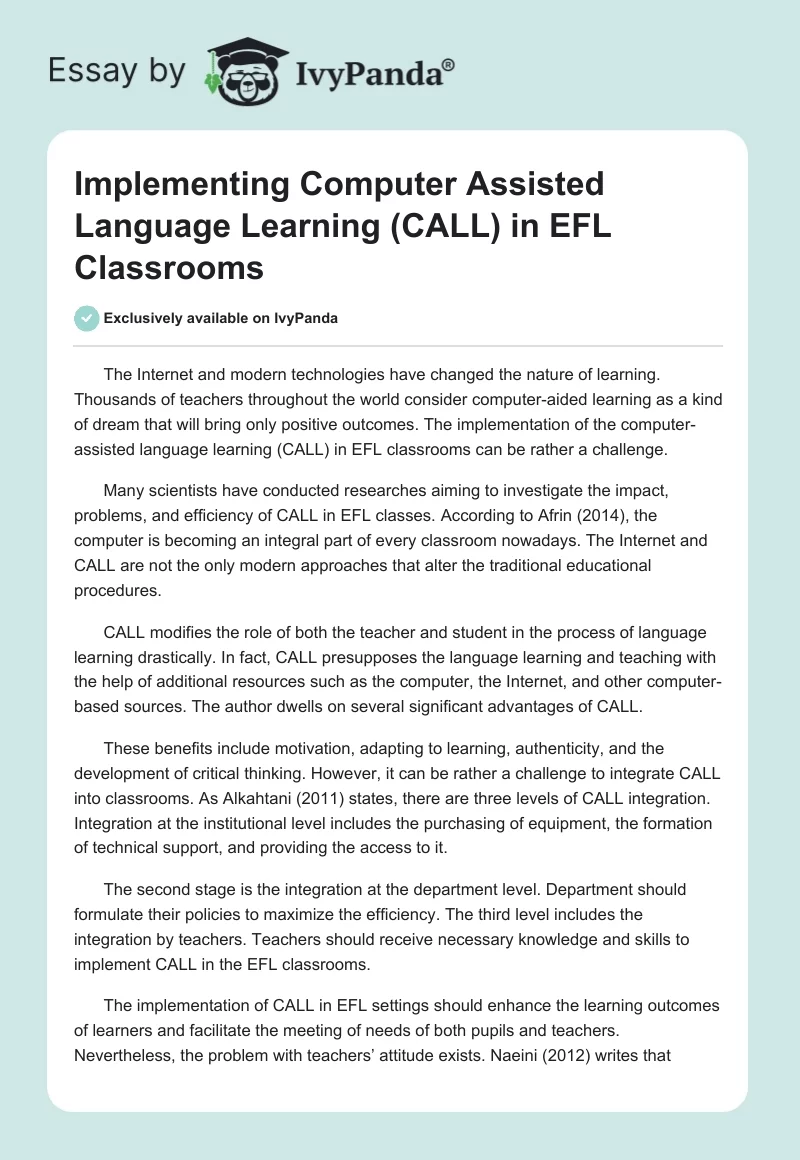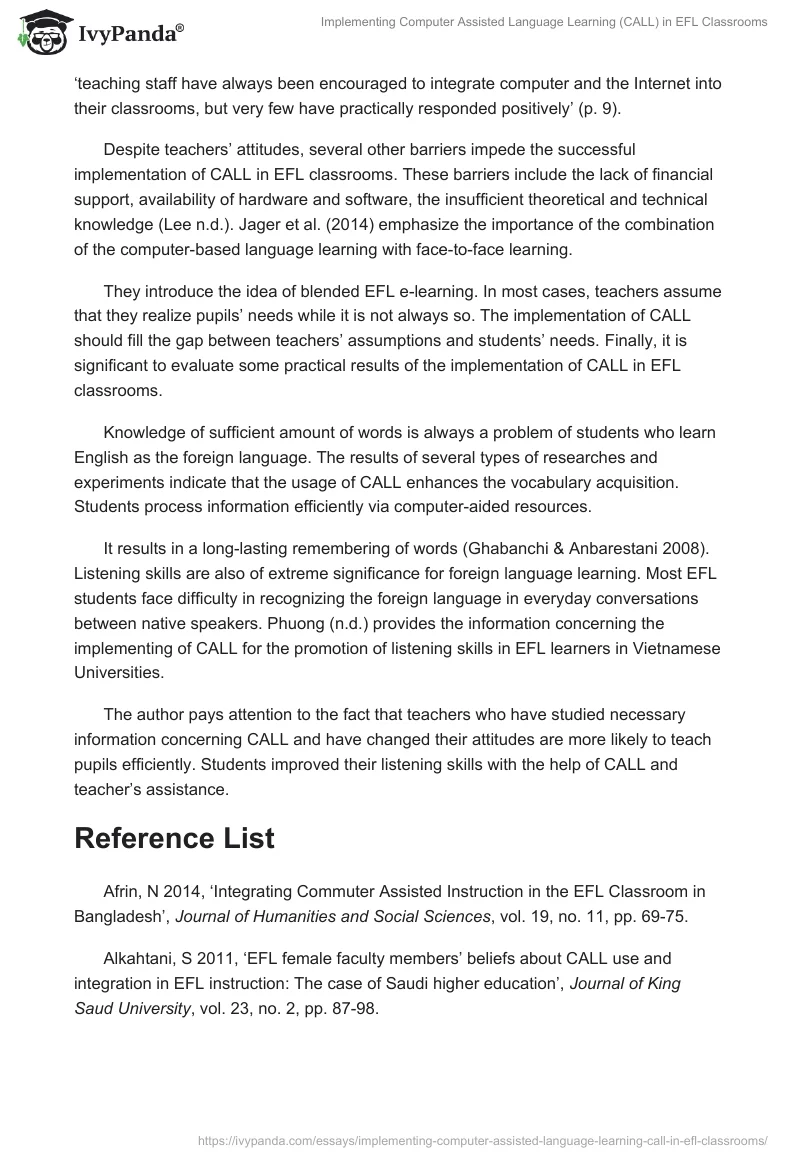The Internet and modern technologies have changed the nature of learning. Thousands of teachers throughout the world consider computer-aided learning as a kind of dream that will bring only positive outcomes. The implementation of the computer-assisted language learning (CALL) in EFL classrooms can be rather a challenge.
Many scientists have conducted researches aiming to investigate the impact, problems, and efficiency of CALL in EFL classes. According to Afrin (2014), the computer is becoming an integral part of every classroom nowadays. The Internet and CALL are not the only modern approaches that alter the traditional educational procedures.
CALL modifies the role of both the teacher and student in the process of language learning drastically. In fact, CALL presupposes the language learning and teaching with the help of additional resources such as the computer, the Internet, and other computer-based sources. The author dwells on several significant advantages of CALL.
These benefits include motivation, adapting to learning, authenticity, and the development of critical thinking. However, it can be rather a challenge to integrate CALL into classrooms. As Alkahtani (2011) states, there are three levels of CALL integration. Integration at the institutional level includes the purchasing of equipment, the formation of technical support, and providing the access to it.
The second stage is the integration at the department level. Department should formulate their policies to maximize the efficiency. The third level includes the integration by teachers. Teachers should receive necessary knowledge and skills to implement CALL in the EFL classrooms.
The implementation of CALL in EFL settings should enhance the learning outcomes of learners and facilitate the meeting of needs of both pupils and teachers. Nevertheless, the problem with teachers’ attitude exists. Naeini (2012) writes that ‘teaching staff have always been encouraged to integrate computer and the Internet into their classrooms, but very few have practically responded positively’ (p. 9).
Despite teachers’ attitudes, several other barriers impede the successful implementation of CALL in EFL classrooms. These barriers include the lack of financial support, availability of hardware and software, the insufficient theoretical and technical knowledge (Lee n.d.). Jager et al. (2014) emphasize the importance of the combination of the computer-based language learning with face-to-face learning.
They introduce the idea of blended EFL e-learning. In most cases, teachers assume that they realize pupils’ needs while it is not always so. The implementation of CALL should fill the gap between teachers’ assumptions and students’ needs. Finally, it is significant to evaluate some practical results of the implementation of CALL in EFL classrooms.
Knowledge of sufficient amount of words is always a problem of students who learn English as the foreign language. The results of several types of researches and experiments indicate that the usage of CALL enhances the vocabulary acquisition. Students process information efficiently via computer-aided resources.
It results in a long-lasting remembering of words (Ghabanchi & Anbarestani 2008). Listening skills are also of extreme significance for foreign language learning. Most EFL students face difficulty in recognizing the foreign language in everyday conversations between native speakers. Phuong (n.d.) provides the information concerning the implementing of CALL for the promotion of listening skills in EFL learners in Vietnamese Universities.
The author pays attention to the fact that teachers who have studied necessary information concerning CALL and have changed their attitudes are more likely to teach pupils efficiently. Students improved their listening skills with the help of CALL and teacher’s assistance.
Reference List
Afrin, N 2014, ‘Integrating Commuter Assisted Instruction in the EFL Classroom in Bangladesh’, Journal of Humanities and Social Sciences, vol. 19, no. 11, pp. 69-75.
Alkahtani, S 2011, ‘EFL female faculty members’ beliefs about CALL use and integration in EFL instruction: The case of Saudi higher education’, Journal of King Saud University, vol. 23, no. 2, pp. 87-98.
Ghabanchi, Z & Anbarestani, M 2008, ‘The Effects of Call Program On Expanding Lexical Knowledge Of EFL Iranian Intermediate Learners’, The Reading Matrix, vol. 8, no. 2, pp. 86-95.
Jager, S, Bradley, L, Meima, E & Thouesny, S 2014, CALL Design: Principles and Practice, Research Publishing, Dublin.
Lee, K n.d., English Teachers’ Barriers to the Use of Computer-assisted Language Learning. Web.
Naeini, M 2012, ‘Meeting EFL Instructors’ Needs through Developing Computer Assisted Language Learning (CALL)’, International Journal of Language Teaching and Research, vol. 1, no. 1, pp. 9-12.
Phuong, L n.d., Adopting CALL to Promote Listening Skills for EFL Learners in Vietnamese Universities. Web.


